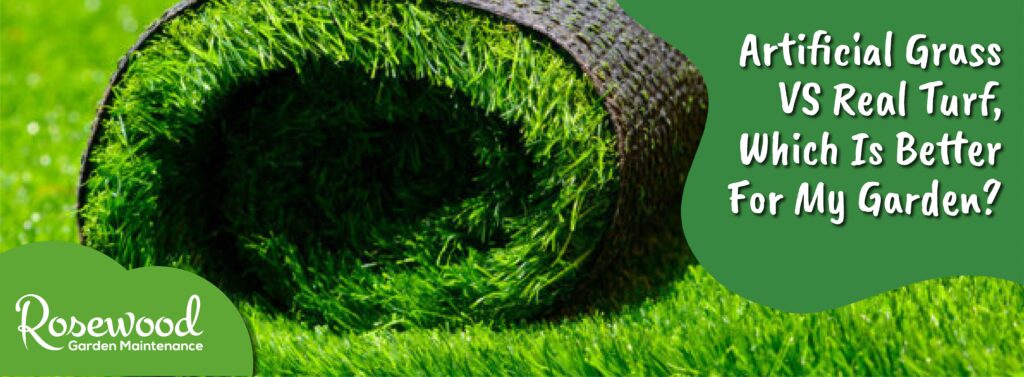
It’s that time of year again where many gardens get an upgrade just in time for Summer. Perhaps you’re stuck deciding between traditional turf, and the ever-popular artificial alternative? Both choices have their benefits, so in our latest blog, we thought we’d go through the pros and cons of each.
Things to think about before you decide
It’s important to think about what your garden is used for. Do you have pets? Do you have children that will play outside frequently? What is your budget? How much money do you want to spend on the maintenance of the lawn? Do you have the time for regular upkeep?
Once you have the answers to some of these questions, it will help you weigh up the pros and cons of both turf and artificial grass. So let’s get started!

Price of artificial grass vs turf
There’s no way around it, turning your lawn artificial would have a significantly higher start-up cost. Fake turf itself is much more expensive than real turf. (We know there are cheap artificial grass options out there, but trust us, it’s just not worth it!)
One square metre of lawn turf can start from just £3, whereas a middle-range artificial turf starts from £20+ per square metre.
Despite what you may think, laying an artificial lawn is not just a case of rolling it out like a huge rug. Your old ground will need to be dug up, and a layer of weed control membrane added. Sand and rubber pellets will also be added for drainage (no one wants a soggy lawn). Unless you know what you’re doing, this job is best left to the professionals, so you will need to add labour on top of the initial product cost.
Turf: 1 Artificial grass: 0
Maintaining artificial grass vs real grass
The main reason there’s been such a boom in the sales of artificial grass is that it requires a lot less upkeep than real grass. This is especially true for people in suburban areas with smaller gardens.
That doesn’t mean that you can just leave it alone, though. It will require sweeping and will need to be watered occasionally, more so if you have pets or a lot of birds nesting above (that use your grass as their bathroom!)
Turf: 1 Artificial grass: 1

Biodiversity and environmental factors
Plastic grass is exactly what it says on the tin… plastic. It doesn’t offer a homely environment for wildlife in any shape or form and contributes to the ever-growing amount of plastic in our landfills when you’re done with it.
Real grass, on the other hand, absorbs dust and carbon dioxide, and in return gives us oxygen through photosynthesis. It houses a wealth of wildlife, from spiders to ants and earthworms.
Turf: 2 artificial grass: 1
So, should you fake it, or not?
If you’re fed up with your patchy lawn, or if you feel like it’s in need of some TLC, then perhaps the first thing to do would be to consult with your local gardening services provider to see if there’s anything that can be done to bring your lawn back to life. Our professional team of experienced gardeners are passionate about all things horticulture and would love nothing more than to help bring your gardens back to their former glory.
Here at Rosewood, we are a bit biased when it comes to real grass, we don’t think you can beat it! But in reality, there is no right or wrong answer when it comes to what works best for you and your lawn. Upkeep and cost are the two main factors that are going to influence your decision, and we hope this blog has been helpful in helping you reach that decision. If you would like a consultation to see what work is needed in your garden, then please do get in touch, or follow our Facebook and Instagram pages for more examples of our gardening services!






